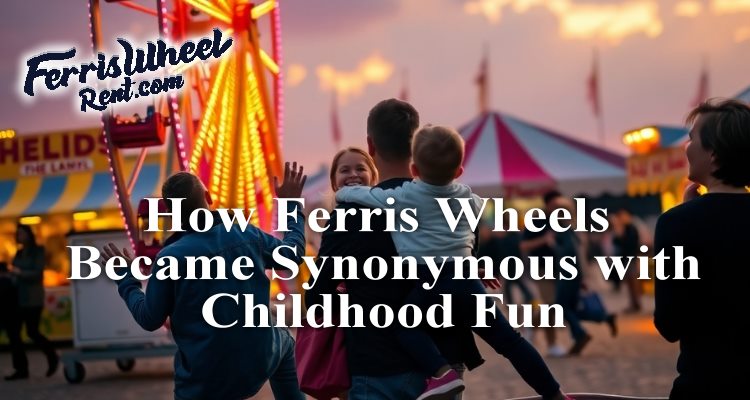From towering steel wheels glowing under carnival lights to small-town fairground attractions spinning slowly under the summer sun, Ferris wheels have long captured the imagination of both children and adults. While roller coasters may offer adrenaline and bumper cars bring laughs, the Ferris wheel stands apart as a symbol of wonder, timelessness, and innocent joy. But how did these giant rotating wheels become so closely associated with childhood fun? Let’s take a nostalgic ride through history and explore how Ferris wheels earned their place at the heart of family memories.
The Invention of the Ferris Wheel
From towering steel wheels glowing under carnival lights to small-town fairground attractions spinning slowly under the summer sun, Ferris wheels have long captured the imagination of both children and adults. While roller coasters may offer adrenaline and bumper cars bring laughs, the Ferris wheel stands apart as a symbol of wonder, timelessness, and innocent joy. But how did these giant rotating wheels become so closely associated with childhood fun?
Let’s take a nostalgic ride through history and explore how Ferris wheels earned their place at the heart of family memories.
The story begins in 1893 at the Chicago World's Fair, officially known as the World's Columbian Exposition. Engineer George Washington Gale Ferris Jr. designed the first-ever Ferris wheel as the American answer to the Eiffel Tower. Standing 264 feet tall, it was a daring feat of engineering that offered a breathtaking view of the fairgrounds and beyond.
This original wheel was more than just a structure—it was an experience. Riders paid 50 cents (a significant amount at the time) for two revolutions, which provided a panoramic view unlike anything the public had seen before. It was immediately recognized not only for its innovation but for its entertainment value.
Ferris Wheels and the Golden Age of Carnivals
By the early 20th century, Ferris wheels became a staple of traveling carnivals and state fairs across the United States. As these family-friendly attractions made their way from town to town, they brought with them a sense of excitement and community gathering. Ferris wheels quickly transformed from a world’s fair marvel into a beloved piece of Americana.
The carnival rides industry evolved, but the Ferris wheel remained a constant fixture, symbolizing simple, wholesome fun. Unlike roller coasters, which might intimidate smaller children, Ferris wheels offered a safe, slow-paced ride that allowed families to enjoy the sights together.
The View from the Top: A Child’s Perspective
For many children, their first ride on a Ferris wheel is unforgettable. Suspended high above the crowds, nestled safely in a gently swaying gondola, a child’s world suddenly expands. The lights below twinkle like stars, the wind brushes past, and for a few magical minutes, they're on top of the world.
This sensation of gentle wonder makes Ferris wheels unique among fairground attractions. While many carnival rides deliver a jolt or thrill, Ferris wheels offer peace, perspective, and a chance to feel grown-up—without being too scary.
It’s this emotional blend that has helped Ferris wheels become synonymous with childhood fun. Parents enjoy the ride for the nostalgia; kids love it for the adventure.
Ferris Wheels in Pop Culture and Family Traditions
Over the years, Ferris wheels have become visual shorthand in media and advertising for joy, nostalgia, and innocence. Think about any classic coming-of-age movie; chances are there's a romantic or sentimental Ferris wheel scene somewhere in it.
This cultural association further cemented the Ferris wheel’s place in our collective childhood memories. Photos from county fairs, Instagram posts from theme parks, and even wedding proposals often feature Ferris wheels in the background, because they capture a feeling of timeless happiness.
Many families also make Ferris wheels a tradition. Whether they visit the same fair each summer or seek out a Ferris wheel at every amusement park they visit, it becomes part of a child’s personal story. In this way, Ferris wheel rentals for private events and school carnivals have also grown in popularity, offering communities a nostalgic yet fresh source of kids' entertainment.
The Rise of Ferris Wheel Rentals and Custom Experiences
As nostalgia-driven events and family-oriented marketing continue to grow, so does the Ferris wheel rentals business. Event planners, schools, and corporate retreats are increasingly including Ferris wheels in their entertainment lineup—not just because they’re visually impressive, but because they’re universally loved.
Whether it’s a temporary installation at a shopping mall, a church fundraiser, or a child’s birthday party, bringing in a Ferris wheel creates instant magic. It draws attention, delights all ages, and provides the kind of wholesome entertainment that never goes out of style.
This trend speaks volumes about our emotional connection to these iconic amusement rides, even in a digital age where virtual reality and mobile gaming dominate, nothing quite compares to the real-world joy of riding high above the crowd in a slowly spinning wheel.
Conclusion: A Symbol of Joy that Spins Through Generations
So why did Ferris wheels become synonymous with childhood fun? Because they offer something universal: a gentle adventure, a shared family moment, and a panoramic view of joy. From the 1893 World’s Fair to today’s local festivals and traveling carnivals, Ferris wheels have been quietly spinning their way into our hearts for over a century.
Whether you're 5 or 85, stepping into a Ferris wheel gondola feels like pressing pause on a busy world—and stepping into a cherished memory. In that way, the Ferris wheel isn't just a ride; it’s a reminder of what fun used to be—and still can be.

